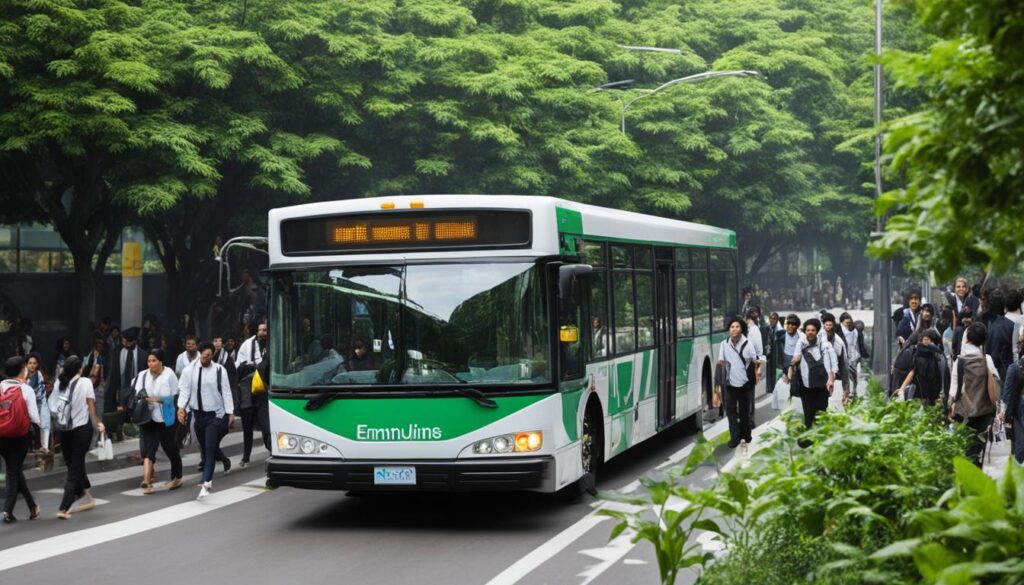If you’re looking for eco-friendly travel options, sustainable transportation for travel is the way to go. With sustainable travel solutions, you can reduce your carbon footprint and make a positive impact on the environment. Green transportation for travelers is becoming increasingly popular, and there are now many environmentally friendly transport options available.
In this section, we’ll introduce you to various sustainable transportation options that can be used for eco-friendly travel. Discover how green transportation can make your travels more sustainable and enjoyable. By choosing eco-friendly travel options, you can contribute to a greener future while exploring the world.
Why Sustainable Transportation Matters
Traveling sustainably has become more important than ever, and using low-carbon travel options is necessary to decrease the environmental impact of traveling. Sustainable travel solutions like green commuting options help combat climate change, reducing the carbon footprint of travelers while ensuring a cleaner and safer environment.
Reducing the environmental impact of travel also promotes a healthier planet, and sustainable travel tips can help travelers contribute to a greener future. By making small changes, you can make a big difference in promoting eco-friendly travel options and sustainable transportation alternatives
How Sustainable Travel Tips Can Help
Here are some tips to make your travel more sustainable:
- Avoid single-use plastics and carry a refillable water bottle
- Use e-tickets and digital guides instead of paper-based materials
- Choose accommodation that follows eco-friendly practices
- Take direct flights instead of having layovers to reduce carbon emissions
- Choose green commuting options like public transportation, cycling, or walking
Not only do these green travel tips reduce your environmental impact, but they also create unique travel experiences, allowing you to immerse yourself in local cultures and explore new destinations sustainably.
The Importance of Low-Carbon Travel Options
Low-carbon travel options like green commuting and sustainable transportation alternatives are critical to combating climate change and its effects on the environment. Through its lower carbon emissions, choosing eco-friendly travel options helps to minimize your impact on the planet and create a more sustainable future.
“Sustainable transportation alternatives help promote environmentally friendly transport and encourage travelers to make a positive impact on the world around them.”
If you’re looking for green transportation for travelers, consider these low-carbon travel options:
| Transportation Option | Pros | Cons |
|---|---|---|
| Public Transportation | Environmentally friendly, cost-effective, and convenient | Restricted to specific destinations |
| Cycling | Good exercise, low carbon emissions, and flexible | May not be suitable for long distances |
| Walking | Good exercise, enjoyable, and eco-friendly | Slower mode of transportation than others |
| Carpooling | Cost-effective, social, and environmentally friendly | Requires extra planning with others and may not be suitable for long distances |
| Electric Vehicles | Low or no carbon emissions if powered by renewable sources, energy-efficient, and green | High initial cost of buying an electric vehicle and limited charging infrastructure in some areas |
By utilizing eco-friendly travel options, you can reduce your carbon footprint and contribute to sustainable tourism.
Public Transportation: The Green Choice
When it comes to eco-conscious travel, public transportation should be at the top of your list. Not only is it a sustainable transport alternative, but it offers a range of green commuting options that can help you reduce your carbon footprint and save money on travel expenses.
One of the biggest benefits of using public transportation for sustainable travel is that it helps reduce traffic congestion and air pollution. By choosing to travel on buses, trains, or subways, you’re contributing to a cleaner environment by lowering the number of single-passenger vehicles on the road.
Another advantage of public transportation is that it can be a convenient and affordable way to get around cities and towns. Many public transportation systems have extensive networks that provide reliable and frequent services to popular destinations, making it easy to reach your desired location without the hassle and expense of driving.
Types of Public Transportation Systems
There are various types of public transportation systems available, each with its unique features and benefits:
| Type of Public Transportation | Description |
|---|---|
| Buses | Provide flexible and widespread transport options, with regular schedules and often multiple routes to chose from. |
| Trains | Includes local and long-distance rail services, including subways, light rail, and commuter trains that can be an efficient and cost-effective way to travel between cities and suburbs. |
| Taxis and ride-sharing services | Can be a sustainable choice as long as they are shared with others, helping to reduce emissions. |
Many public transportation systems now offer eco-friendly options, such as hybrid or electric buses and trains, and encourage passengers to bring reusable bags and opt for paperless tickets. By taking advantage of these green commuting options, you can do your part in protecting the environment while enjoying the convenience of public transportation.
Next time you’re planning a trip, consider choosing public transportation as a sustainable and environmentally friendly mode of transport. Choose to reduce your carbon footprint, save money, and enjoy a relaxing journey.
Cycling: Pedal Power for Sustainable Travel
Looking for a sustainable and adventurous way to explore new destinations? Look no further than cycling! Cycling is an eco-friendly and beneficial mode of transportation that allows you to experience your surroundings in a unique and captivating way.
Whether you’re commuting to work or exploring a new city, cycling promotes sustainable travel solutions and helps reduce carbon emissions. Plus, it’s affordable and great exercise.
Not sold on the idea yet? Here are some more reasons to consider cycling for sustainable travel:
- Reduced environmental impact: Cycling doesn’t produce any emissions and has a lower carbon footprint than most other modes of transportation.
- Promotes physical activity: Cycling is a great form of exercise. It can help improve your cardiovascular health and build muscle strength.
- Cost-effective: Bikes are relatively inexpensive compared to other modes of transportation, and once you purchase one, there are few ongoing costs.
- Faster city travel: In busy cities, cycling can often be faster than driving or taking public transportation.
So the next time you’re planning a trip, consider renting a bike or bringing your own to explore your destination in a sustainable and eco-friendly way.
“Cycling isn’t a hobby, it’s a lifestyle.”
Bicycling in Action: A Case Study
| City | Average Trip Time (by Bike) | Average Cost (Per Month) |
|---|---|---|
| Amsterdam, Netherlands | 20 minutes | $0 (most bicycles are privately owned) |
| Copenhagen, Denmark | 30 minutes | $20 (for maintenance and repair costs) |
| Barcelona, Spain | 40 minutes | $50 (for maintenance, repairs, and bike rental) |
As shown in the case study table, bikes can provide fast and efficient travel, regardless of your destination. Plus, the ongoing cost of owning and maintaining a bike is low compared to other modes of transportation.
So why not give cycling a try and explore the world sustainably on two wheels?
Walking: Step into Sustainable Travel
If you’re looking for a simple and eco-friendly way to explore a new destination, walking might be the answer. Walking is a great way to reduce your carbon footprint while also enjoying the sights and sounds of a place up close. It’s one of the most sustainable transport options available, leaving no carbon emissions and allowing you to take in the local atmosphere at your own pace.
Here are some sustainable travel tips for incorporating walking into your travel plans:
- Pack comfortable shoes: Whether you plan on a leisurely stroll or an extensive trek, comfortable shoes are a must when it comes to walking. Opt for shoes that you’ve broken in and fit well to avoid blisters and other foot injuries.
- Use a map: A map can guide you through your walking route while also highlighting points of interest and local landmarks. Take the time to plan out your walk and ensure you cover all the places you wish to see.
- Choose eco-friendly accommodation: Opt for accommodations that are within walking distance of local sights and attractions for convenience and an easy commute. This way, you’re avoiding taxis, buses, and other vehicles that release harmful emissions into the air.
- Join a walking tour: Many cities offer walking tours that introduce you to the local history and architecture while giving you the chance to stretch your legs. Walking tours are led by knowledgeable guides who share fascinating insights and stories.
Walking is not only healthy but also a sustainable and affordable way to get around your destination. It’s also an excellent opportunity to explore hidden gems, meet locals, and create unforgettable memories. So, put on your walking shoes, and start exploring!
Carpooling: Sharing Rides for a Greener Journey
If you’re looking for an easy way to make your travel more environmentally friendly, consider carpooling. By sharing rides with others, you can reduce the number of vehicles on the road, which helps lower carbon emissions and decrease traffic congestion. Not to mention, carpooling can save you money on transportation costs!
There are many options for finding carpooling opportunities, such as online platforms like Ridejoy, CarpoolWorld, or LyftLine, or asking around in your community. In addition, some cities have dedicated carpool lanes, making the commute quicker and more efficient.
Not only is carpooling an eco-friendly option, but it can also be a social experience. You may meet new people and make friends while sharing a ride. Carpooling is also a great solution for those who don’t have access to sustainable transport alternatives like biking or walking.
Next time you plan a trip, consider carpooling as a green commuting option and join the worldwide effort for environmentally friendly transport.
Electric Vehicles: The Future of Sustainable Travel
Electric vehicles (EV) are revolutionizing the way we travel sustainably. With zero tailpipe emissions, EVs are a low-carbon travel option that significantly reduces greenhouse gas emissions. Compared to traditional gasoline-powered vehicles, EVs are more eco-friendly and offer sustainable transport alternatives for environmentally conscious travelers like you.
One of the main benefits of owning an EV is that it reduces your carbon footprint. With governments and manufacturers investing in charging infrastructure, using an EV is becoming increasingly convenient. EVs are also cheaper to run and maintain, resulting in long-term cost savings, making it an attractive prospect for eco-friendly travel options.
Fun Fact: Did you know that the Tesla Model S has a range of up to 402 miles per charge?
EVs are not just limited to cars; electric buses and trains are also shaping the future of sustainable travel. Electric buses have been gaining popularity in cities across the world as a sustainable transport alternative to traditional diesel-fueled buses. Their large batteries allow them to run for longer periods, and they produce no emissions while driving, making them ideal for urban environments.
With increasing interest in sustainable travel options, more people are opting for EVs. EVs are also an excellent way to reduce noise pollution in urban areas. As battery technology continues to develop and investments are made in charging infrastructure, EVs will become more efficient and mainstream.
Eco-Friendly Train Travel: All Aboard!
Train travel is a sustainable and eco-conscious way to explore the world while minimizing your impact on the environment. Unlike cars and planes, which contribute to carbon emissions, trains offer a low-carbon transportation option for travelers.
Additionally, riding the train can be a charming and picturesque way to enjoy your journey. You can take in the views from the window, relax in comfortable seats, and even have a meal or a drink in the dining car.
Trains also provide an opportunity to interact with fellow travelers, which can be a great way to make new friends or simply share travel tips and stories. And with stations in many city centers, trains can be a convenient transportation option for eco-conscious travelers looking to see the sights without having to rent a car or rely on taxis.
If you’re looking for sustainable travel solutions, consider taking the train for your next adventure. All aboard!
Train Travel: Quick Facts
| Advantages | Disadvantages |
|---|---|
|
|
Sustainable Air Travel: Minimizing Your Impact
When it comes to air travel, it’s no secret that planes emit a large amount of CO2 and contribute to climate change. But there are ways to minimize the environmental impact of flying and make air travel more sustainable.
“Sustainable air travel is all about reducing emissions and protecting the environment while still enjoying the benefits of air travel,” says Andrew Greene, a sustainable travel expert.
Eco-Friendly Tips for Air Travel
Here are some sustainable travel tips you can follow to minimize your impact when flying:
- Choose non-stop flights whenever possible, as takeoff and landing are the most carbon-intensive parts of a flight.
- Consider purchasing carbon offsets to compensate for the emissions from your flight.
- Pack light to reduce fuel consumption and emissions
- Avoid single-use plastics and bring reusable alternatives such as a refillable water bottle or container.
- Choose airlines with sustainable travel programs and eco-friendly initiatives.
Sustainable Practices for Airlines
Airlines can also take action to minimize their environmental impact, including:
- Investing in more fuel-efficient planes.
- Implementing sustainable practices such as reducing waste, plastic, and water use.
- Using eco-friendly materials for inflight services, such as cutlery made from biodegradable or compostable materials.
- Partnering with organizations to promote and support sustainable travel.
CO2 Emissions by Flight Class
| Flight Class | Short Haul | Medium Haul | Long Haul |
|---|---|---|---|
| Economy class | 37 | 116 | 440 |
| Premium economy | 74 | 232 | 881 |
| Business class | 111 | 349 | 1,321 |
| First class | 222 | 695 | 2,642 |
*Emissions based on a one-way flight and the occupancy of the plane
By following eco-friendly practices and choosing sustainable airlines, we can all play a part in minimizing our impact while still enjoying the benefits of air travel.
Cruise Ships: Sailing Towards Sustainability
If you’re looking for an eco-conscious way to travel the high seas, there are sustainable options for you. Cruise lines are taking steps to reduce their environmental impact and offer eco-friendly journeys for passengers. From low-carbon travel options to sustainable transport alternatives, here’s what you need to know about sustainable cruise ship travel.
Eco-Friendly Cruise Lines
Many cruise lines are embracing sustainable practices, such as reducing plastic waste, promoting responsible tourism, and supporting local communities. For example, Norwegian Cruise Line has eliminated single-use plastics across its fleet and partners with environmental organizations to promote conservation efforts. Another eco-friendly option is Hurtigruten, a Norwegian cruise line that operates a fleet of hybrid ships powered by renewable energy sources.
Onboard Initiatives
Cruise lines are implementing initiatives to reduce their carbon footprint and promote sustainable travel. For instance, some ships use advanced wastewater treatment systems and rely on shore power to reduce emissions. Other ships have installed LED lighting or utilize energy-efficient appliances and fixtures. Additionally, some ships utilize sustainable food practices by sourcing local ingredients and reducing food waste.
Responsible Tourism
Sustainable cruise ship travel is also about making responsible tourism choices. When you book a shore excursion, consider eco-conscious options that have a lesser impact on the environment and support local communities. For example, instead of a bus tour, you could rent a bicycle or kayak to explore your destination. You could also select shore excursions that involve community projects or cultural experiences that promote sustainable practices.
The Importance of Sustainable Cruise Ship Travel
As the cruise industry continues to grow, it’s crucial to prioritize sustainability and reduce the environmental impact of these journeys. Low-carbon travel options and sustainable transport alternatives can help reduce greenhouse gas emissions and mitigate the negative effects of tourism on local ecosystems. By choosing eco-friendly cruise lines and making responsible tourism choices, you can make a difference and support a more sustainable future for our planet.
Sustainable Travel Tips: Make a Difference
Traveling sustainably doesn’t have to be difficult. By making a few small changes, you can reduce your carbon footprint and contribute to a greener planet. Here are some sustainable travel tips to help you make a difference:
1. Use Sustainable Transportation
Choose eco-friendly travel options such as public transportation, cycling, and walking whenever possible. By avoiding rental cars and taxis, you can significantly reduce your carbon emissions. Consider booking a green hotel that offers sustainable transport alternatives to explore the local area.
2. Pack Light
The more weight you carry, the more fuel is needed to transport you. Travel light when possible by packing only the essentials and avoiding unnecessary items. Not only will this reduce your carbon footprint, but it will also make your travels more comfortable and hassle-free.
3. Reduce Plastic Use
Carry a reusable water bottle and fill it up at water fountains to reduce your plastic waste. Bring a reusable shopping bag for souvenirs and snacks, and use a spork or other reusable utensils to avoid disposable plastic ones. Reduce your carbon footprint by bringing your own food container when getting take-away food.
4. Book Sustainable Accommodations
Choose eco-friendly hotels that make an effort to minimize their environmental impact. Check if the hotel has a sustainability certification like Green Key or Eco-label, if it composts its food waste or uses solar panels. Additionally, they should also offer opportunities for guests to save water and energy.
5. Respect Local Culture and Environment
Be respectful of the local culture and environment by learning about their customs and taking steps to reduce your impact. Dress appropriately for temple visits or national parks, and avoid taking natural resources like rocks, shells, or sand. Leave nature as you found it and pick up litter when you can.
6. Shop Locally
Support local businesses and reduce your carbon footprint by shopping for souvenirs at markets and small independent stores. Avoid big chain stores and supermarkets that may have lower prices but sell imported goods from afar. Try local food or take a cooking class when possible to learn about local cuisine and reduce food miles.
7. Offset Your Carbon Emissions
Calculate and offset your carbon emissions by supporting carbon neutral initiatives and projects. There are many online calculators that estimate the carbon emissions of your trip, and several organizations offer carbon offset programs that plant trees or invest in renewable energy.
By incorporating these sustainable travel tips into your adventures, you can make a positive impact on the planet and create memorable experiences at the same time.
Conclusion
Congratulations on completing this guide to sustainable transportation options for travel! By choosing to travel in an eco-friendly way, you are taking a step towards reducing your carbon footprint and helping to combat climate change.
Remember, there are many sustainable transportation options available to you, including public transportation, cycling, walking, carpooling, electric vehicles, and trains, all of which can contribute to a greener future.
Incorporating sustainable travel practices into your journeys is easy and can make a big difference. From packing light and bringing your reusable water bottle to choosing eco-friendly accommodations, every small step counts.
So, next time you plan a trip, consider opting for a sustainable transportation option and enjoy the benefits of exploring the world while minimizing your impact on the environment.
Thank you for reading and happy travels!

















































